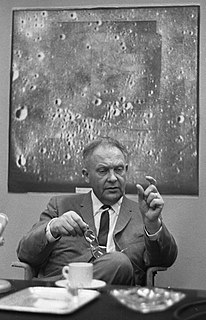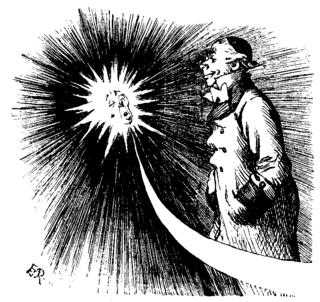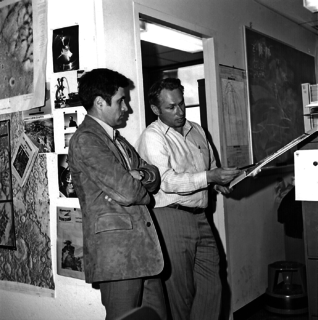External links
- University of Arizona – Robert S. (Bob) McMillan
- UA Science, Lunar and Planetary Laboratory – Bob McMillan
| This United States astronomer article is a stub. You can help Wikipedia by expanding it. |
Robert S. McMillan is an astronomer at the University of Arizona, and heads the Spacewatch project, which studies minor planets. He has made various discoveries, including notably 20000 Varuna. [1]
On October 19, 2008 he discovered a short-periodic comet 208P/McMillan. [2]
In 1977 McMillan received his Ph.D. from the University of Texas at Austin.
| This United States astronomer article is a stub. You can help Wikipedia by expanding it. |

Gerard Peter Kuiper was a Dutch astronomer, planetary scientist, selenographer, author and professor. He is the eponymous namesake of the Kuiper belt.

The Discovery Program is a series of Solar System exploration missions funded by the US National Aeronautics and Space Administration (NASA) through its Planetary Missions Program Office. Each mission has a cost cap, at a lower level than a mission from NASA's New Frontiers or Flagship Programs. As a result, Discovery missions tend to be more focused on a specific scientific goal.

Lowell Observatory Near-Earth-Object Search (LONEOS) was a project designed to discover asteroids and comets that orbit near the Earth. The project, funded by NASA, was directed by astronomer Ted Bowell of Lowell Observatory in Flagstaff, Arizona. The LONEOS project began in 1993 and ran until the end of February 2008.

The Spacewatch project is an astronomical survey that specializes in the study of minor planets, including various types of asteroids and comets at Kitt Peak National Observatory near Tucson, Arizona, in the United States.

Anton M.J. "Tom" Gehrels was a Dutch–American astronomer, Professor of Planetary Sciences, and Astronomer at the University of Arizona, Tucson.

William Frederick Denning was a British amateur astronomer who achieved considerable success without formal scientific training. He is known for his catalogues of meteor radiants, observations of Jupiter's red spot, and for the discovery of five comets.
James Vernon Scotti is an American astronomer. He was born in Bandon, Oregon and graduated from Woodway Senior High in Edmonds, Washington in 1978. He received his B.Sc. in Astronomy from the University of Arizona in Tucson in 1983. Ever since that time, he has worked on the Spacewatch project, which is one of a number of projects that look for near-Earth asteroids (NEAs). He wrote the first automatic asteroid detection software for the project in 1984.
Andrea Boattini is an Italian astronomer and a prolific discoverer of minor planets and comets.

Henry E. Holt is an American astronomer and prolific discoverer of minor planets and comets, who has worked as a planetary geologist at the United States Geological Survey and Northern Arizona University.
Carl William Hergenrother is an American astronomer and discoverer of minor planets and comets.
The Palomar Planet-Crossing Asteroid Survey (PCAS) was an astronomical survey, initiated by American astronomers Eleanor Helin and Eugene Shoemaker at the U.S Palomar Observatory, California, in 1973. The program is responsible for the discovery of 95 near-Earth Objects including 17 comets, while the Minor Planet Center directly credits PCAS with the discovery of 20 numbered minor planets during 1993–1994. PCAS ran for nearly 25 years until June 1995. It had an international extension, INAS, and was the immediate predecessor of the outstandingly successful NEAT program.

Donald Edward Machholz, born October 7, 1952 in Portsmouth, Virginia, is an American amateur astronomer and science writer who is the most successful living visual comet discoverer. Credited with the discovery of 12 comets, that include the periodic comets 96P/Machholz, 141P/Machholz, the non-periodic C/2004 Q2 (Machholz) that were visible with binoculars in the northern sky in 2004 and 2005, C/2010 F4 (Machholz), and most recently C/2018 V1 (Machholz-Fujikawa-Iwamoto) In 1985, comet Machholz 1985-e, was discovered using a homemade cardboard telescope with a wide aperture, 10 inches across, that gave it a broader field of view than most commercial telescopes. Amateur astronomer Machholz utilizes a variety of methods in his comet discoveries, in 1986 using 29×130 binoculars he discovered 96P/Machholz.
The Lunar and Planetary Institute (LPI) is a scientific research institute dedicated to study of the solar system, its formation, evolution, and current state. The Institute is part of the Universities Space Research Association (USRA) and is supported by the Science Mission Directorate of the National Aeronautics and Space Administration (NASA). Located at 3600 Bay Area Boulevard in Houston, Texas, the LPI maintains an extensive collection of lunar and planetary data, carries out education and public outreach programs, and offers meeting coordination and publishing services. The LPI sponsors and organizes several workshops and conferences throughout the year, including the Lunar and Planetary Science Conference (LPSC) held in March in the Houston area.

The Lunar and Planetary Laboratory (LPL) is a research center for planetary science located in Tucson, Arizona. It is also a graduate school, constituting the Department of Planetary Sciences at the University of Arizona. LPL is one of the world's largest programs dedicated exclusively to planetary science in a university setting. The Lunar and Planetary Lab collection is held at the University of Arizona Special Collections Library.

65803 Didymos, provisional designation 1996 GT, is a sub-kilometer asteroid and synchronous binary system, classified as potentially hazardous asteroid and near-Earth object of both the Apollo and Amor group. The asteroid was discovered in 1996, by the Spacewatch survey at Kitt Peak, and its small 160-metre minor-planet moon was discovered in 2003, named Dimorphos. Due to its binary nature, it was then named "Didymos", the Greek word for twin.
1777 Gehrels, also designated 4007 P-L, is a stony asteroid from the middle region of the asteroid belt, approximately 13 kilometers in diameter. It was discovered during the Palomar–Leiden survey in 1960, and named for astronomer Tom Gehrels, one of the survey's principal investigators and credited discoverer.
C/1992 J1 (Spacewatch) is a comet that was discovered 1 May 1992 by David Rabinowitz of the Spacewatch Project. This was the first comet to be discovered using an automated system.
86P/Wild is a periodic comet in the Solar System with a current orbital period of 6.84 years.
(457175) 2008 GO98, provisional designation 2008 GO98 with cometary number 362P, is a Hildian asteroid and rare main-belt comet from the outermost regions of the asteroid belt, approximately 15 kilometers (9 miles) in diameter. It was discovered on 8 April 2008, by astronomers of the Spacewatch program at Kitt Peak National Observatory near Tucson, Arizona, in the United States. The presumably carbonaceous body has a rotation period of 10.7 hours.
C/2003 A2 (Gleason) is a hyperbolic comet discovered on January 10, 2002 by Arianna E. Gleason of the Lunar and Planetary Laboratory using the Spacewatch II telescope at the Kitt Peak National Observatory. It has a heliocentric semimajor axis of -1641 AU and reached its perihelion of 11.43 AU on November 4, 2003. C/2003 A2 (Gleason) was the first comet discovered with a perihelion beyond 10 AU.